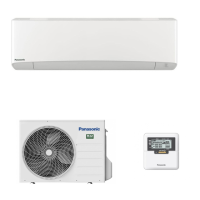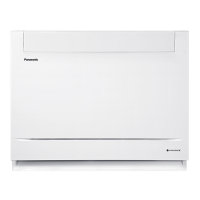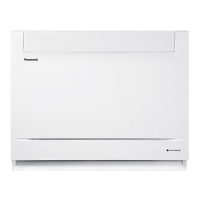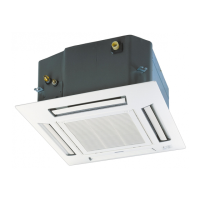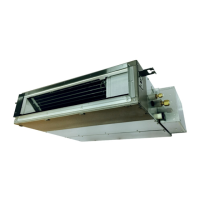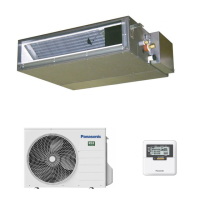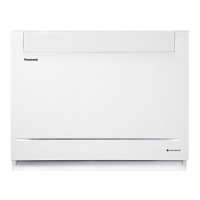53
12. Installation Instruction
12.1 Select the Best Location
12.1.1 Indoor Unit
Do not install the unit in excessive oil fume area
such as kitchen, workshop and etc.
There should not be any heat source or steam
near the unit.
There should not be any obstacles blocking the air
circulation.
A place where air circulation in the room is good.
A place where drainage can be easily done.
A place where noise prevention is taken into
consideration.
Do not install the unit near the door way.
Ensure the spaces indicated by arrows from the
wall, ceiling, fence or other obstacles.
Indoor unit of this air conditioner shall be installed
in a height of at least 1.8 m.
12.1.2 Outdoor Unit
If an awning is built over the unit to prevent direct
sunlight or rain, be careful that heat radiation from
the condenser is not obstructed.
There should not be any animal or plant which
could be affected by hot air discharged.
Keep the spaces indicated by arrows from wall,
ceiling, fence or other obstacles.
Do not place any obstacles which may cause a
short circuit of the discharged air.
If piping length is over the [piping length for
additional gas], additional refrigerant should be
added as shown in the table.
Table A
(*) Systems with total refrigerant charge, m
c
, lower
than 1.84kg are not subjected to any room area
requirements.
Example: For Z25***
If the unit is installed at 10 m distance, the quantity of
additional refrigerant should be 25 g .... (10-7.5) m x
10 g/m = 25 g.
A
min
= (m
c
/ (2.5 × (LFL)
(5/4)
× h
0
))
2
** not less than safety factor margin
A
min
= Required minimum room area, in m
2
m
= Refrigerant charge in appliance, in kg
LFL
= Lower flammability limit (0.307 kg/m
3
)
h
0
= Installation height of the appliance (1.8 m for
wall mounted)
SF
= Safety factor with a value of 0.75
** The required minimum room area, A
min
, shall also
be governed by the safety factor margin formula
below :
A
min
= m
c
/ (SF × LFL × h
0
)
The higher value shall be taken when determining the
room area.
12.1.3 Indoor/Outdoor Unit Installation
Diagram
This illustration is for explanation purposes only.
The indoor unit will actually face a different way.
(*) If holder at the rear of chassis (Refer column
“ 12.2.3 Indoor Unit Installation” ) need to be used to
prop up the unit, this distance shall be 65 mm or more.
Model
Capacity
W
(HP)
Piping size
Std.
Length
(m)
Max.
Elevation
(m)
Min.
Piping
Length
(m)
Max.
Piping
Length
(m)
Additional
Refrigerant
(g/m)
Piping
Length
for add.
gas
(m)
Max.
Refrigerant
Charge
(kg)
Indoor
A
min
(m²)
Gas Liquid
Z25*** 1.0HP
9.52 mm
(3/8")
6.35 mm
(1/4")
5
15 3 20 10 7.5 1.02 Not applicable (*)
)
*
( elb
ac
ilppa to
N
2
0.
1
5
.7
01
02
351PH5.1
*
**
5
3
Z
Z42*** 1.75HP
12.7 mm
(1/2")
15 3 20 10 7.5 1.10 Not applicable (*)
)
*(
elb
a
cilppa
t
oN
74
.
1
5.75103
351
P
H0.2
*
**0
5Z
Z71*** 2.5HP
15.88 mm
(5/8")
20 3 30 25 10 1.85
4.46
Attention not to bend
up drain hose
Piping direction
(Front side)
Right
Right
Rear
Right
bottom
Left
Rear
Left bottom
Left
65 mm
or more
(Left and right are identical)
Installation plate 1
Sleeve (
)
Bushing-Sleeve (
)
Bend the pipe as closely
on the wall as possible,
but be careful that it
doesn’t break.
Saddle ( )
Additional drain hose (
)
Gas side piping ( )
Connection cable
Putty (
)
(Gum Type Sealer)
Liquid side piping ( )
Power supply cord ( )
Flare connection
Vinyl tape (wide) (
)
• Apply after carrying out
a drainage test.
• To carry out the
drainage test, remove
the air fi lters and pour
water into the heat
exchanger.
It is advisable to
avoid more than 2
blockage directions.
For better ventilation
& multiple-outdoor
installation, please
consult authorized
dealer/specialist.
Installation parts you
should purchase (
)
300 mm
or more
100 mm
or more
100 mm
or more
1000 mm
or more
50 mm
or more
(
*
)
50 mm
or more
•
Carry out insulation after
checking for gas leaks and
secure with vinyl tape.
Vinyl tape
Insulation of piping connections
Attaching the remote controller to the wall
Remote controller
cable
Screws 4
or
screws 5
Remote controller 3
Details refer to
REMOTE CONTROLLER
MOUNTING, INSTALLATION
AND CONNECTION
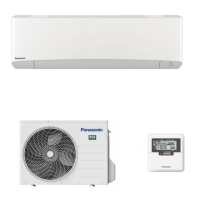
